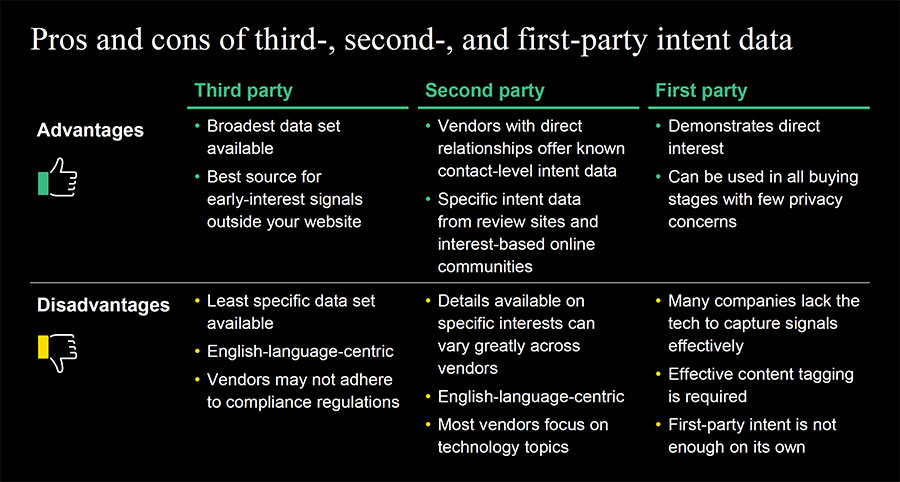Intent data gives B2B marketers a powerful way to stay customer-obsessed. While the topic is not exactly new, Forrester reenergized it (for us anyway) at its B2B Marketing Summit North America. Forrester analyst Brett Kahnke delivered a top-notch presentation on “Making Sense of the B2B Intent Data Landscape,” and it inspired us to continue the conversation.
At Tendo we’ve noticed a growing interest in how to use this data to target the right prospects with the right content at the right moment. But we also see persistent confusion—about how to define data types, where to source it, and how to put it to work for customer journey orchestration and content personalization. Two stats from DemandScience’s report, Intent Data Trends: 2022 Edition, capture this current reality:
- Use of intent data for personalized marketing increased 24% over the past year.
- But 55% of sales and marketing professionals say their teams can’t agree on what constitutes intent data.
Let’s clarify those definitions and explore intent data–driven content personalization use cases in more detail.
The Vision: Intent Data Driving Journey Orchestration
Intent data tantalizes B2B marketers, and it’s not hard to see why. As Gartner defines it, intent data is “information that indicates prospects’ level of interest in a particular product or service online. It includes prospects’ web searches, the pages they visit and the content they consume.”
Imagine having the power to know which individuals and companies are truly ready to make a purchase—versus the low-quality leads that frustrate sales teams. Not only can marketers zero in on those active prospects and accounts—optimizing their team’s time and budget—they can use more granular data to understand whether a prospect is doing initial research or comparing vendor finalists. In this way, intent data can power customer journey orchestration: coordinating digital touchpoints and guiding prospects along a seamless path, customized to their needs and interests at any given moment.
Personalized content plays a major role in this orchestration, both on your own website and outside of it. Content can include personalized offers, messages, and recommendations based on behaviors (e.g., when an individual views a product page multiple times) or firmographics and demographics (e.g., identifying that a prospect is a C-suite executive at an enterprise company in XYZ industry).
Overall, leveraging this data delivers results. A 2023 Forrester survey of B2B sales, marketing, and operations professionals that used intent data reported the following:
- 46% experienced increased sales pipeline
- 50% experienced more successful sales prospecting
- 56% experienced increased response rates to outbound marketing
All of these outcomes are easier said than done, of course. Intent data can be complex. That’s why it’s so important to understand the data types, sources, and technology vendors.
4 Types of Intent Data
Different types of intent data provide varying levels of insight into a prospect’s behavior and makeup, and allow for different types of content personalization. Some types of intent data are more valuable than others, as well as more readily available. But as you review these definitions, remember this caution from Forrester: “Intent signals are evidence but not proof.”
Zero-party intent data
- Definition: Information willingly shared and explicitly provided by customers
- Sources: filled-out forms (from content downloads), customer surveys, user account preferences
- Example: A prospect self-identifies their journey stage by completing form fields with progressive profiling.
First-party intent data
- Definition: Information collected by an organization based on direct interactions with a customer—and captured with that customer’s consent
- Sources: website traffic on owned properties (specific pages viewed, return visits, etc.) captured through first-party cookies, response to email campaigns (click-throughs), interaction with owned social media content
- Example: A prospect downloads a content asset (like an ROI calculator) tagged to the consideration journey phase
Second-party intent data
- Definition: Information purchased from a vendor that is either inferred from publicly available information or based on a direct interaction with an individual or company
- Sources: Review sites or online communities; content syndication services; events and trade shows
- Example: A prospect is identified as having visited review sites for a specific product category.
Third-party intent data
- Definition: Information purchased from a third-party vendor in which consent is not always explicit
- Sources: Digital advertising data, content publishers, publicly available web data
- Example: A prospect is identified as having responded to digital advertising on a topic related to your product or solution

Working with Intent Data
Each of these intent data types has a role to play. Third-party data can help you target prospects on or off your website, often in the early stages of their research and education process. Second-party data can identify accounts and buying groups that have reached the decision stage and are comparing vendor finalists (on a site like G2, for example).
Zero- and first-party data are arguably the highest quality and most valuable. They can demonstrate that a user has direct interest and then allow you to personalize the content experiences on your website. But advanced marketing and sales organizations can layer all of these types of intent data together for the greatest benefits.
No matter where you gather intent data, it can be used to:
- Personalize offers or calls-to-action on your website based on product interest and journey stage
- Initiate ABM or prospect-specific email nurture campaigns
- Retarget high-intent accounts or prospects via social media offers or advertising
- And many other powerful use cases
Choosing Providers and Tools
How do you get your hands on actual intent data and use it to deliver targeted campaigns and personalized content? Forrester describes the four main business models of intent data providers:
- Data providers: Vendors like ZoomInfo and Bombora that sell standalone third-party intent data
- ABM platforms: Platform providers like Demandbase and 6sense that allow you to identify and engage high-intent accounts
- Campaign execution: Vendors like Intentsify and Anteriad that leverage multiple data sources to identify accounts and launch targeted demand generation campaigns
- Walled gardens: Private communities like TechTarget, G2, and TrustRadius that provide access to their user data.
Outside of these four vendor types, you’ll also have to consider a digital experience platform or personalization engine with your CRM that allows you to deliver personalized content on your website, based on the first-party intent data that you harvest.
Where to Start with Data?
Intent data can support your marketing and sales teams in numerous ways. How you use it may depend on your team’s role and objectives. That said, Forrester recommends prioritizing all the first-party data you already own: capturing it and maximize its usage.
As you explore data providers, consider which ones best align with your needs. Just remember to keep your business and marketing goals front and center as your explore your options, rather than getting swayed by fancy technology or highly targeted data to purchase.
Need Help with Personalization?
Talk to Tendo about how to create a personalization framework on your website and put intent data to work to reach your marketing goals. Contact us









